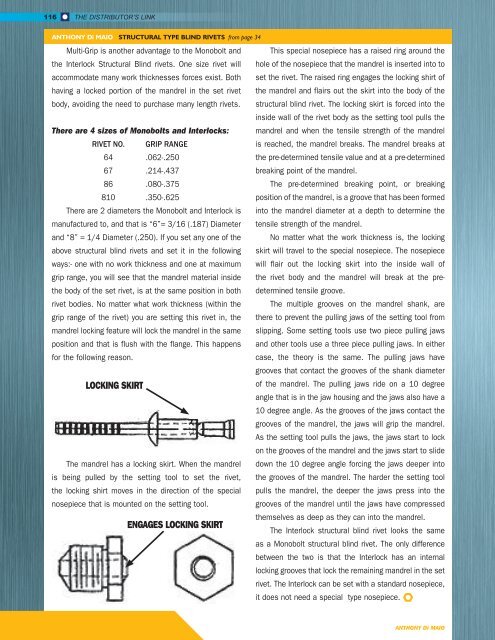SPRING 2018
Distributor's Link Magazine Spring 2018 / Vol 41 No2
Distributor's Link Magazine Spring 2018 / Vol 41 No2
Create successful ePaper yourself
Turn your PDF publications into a flip-book with our unique Google optimized e-Paper software.
116<br />
THE DISTRIBUTOR’S LINK<br />
ANTHONY Di MAIO STRUCTURAL TYPE BLIND RIVETS from page 34<br />
Multi-Grip is another advantage to the Monobolt and<br />
the Interlock Structural Blind rivets. One size rivet will<br />
accommodate many work thicknesses forces exist. Both<br />
having a locked portion of the mandrel in the set rivet<br />
body, avoiding the need to purchase many length rivets.<br />
This special nosepiece has a raised ring around the<br />
hole of the nosepiece that the mandrel is inserted into to<br />
set the rivet. The raised ring engages the locking shirt of<br />
the mandrel and flairs out the skirt into the body of the<br />
structural blind rivet. The locking skirt is forced into the<br />
inside wall of the rivet body as the setting tool pulls the<br />
There are 4 sizes of Monobolts and Interlocks: mandrel and when the tensile strength of the mandrel<br />
RIVET NO. GRIP RANGE<br />
is reached, the mandrel breaks. The mandrel breaks at<br />
64 .062-.250<br />
the pre-determined tensile value and at a pre-determined<br />
67 .214-.437<br />
breaking point of the mandrel.<br />
86 .080-.375<br />
The pre-determined breaking point, or breaking<br />
810 .350-.625<br />
position of the mandrel, is a groove that has been formed<br />
There are 2 diameters the Monobolt and Interlock is<br />
manufactured to, and that is “6”= 3/16 (.187) Diameter<br />
and “8” = 1/4 Diameter (.250). If you set any one of the<br />
above structural blind rivets and set it in the following<br />
ways:- one with no work thickness and one at maximum<br />
grip range, you will see that the mandrel material inside<br />
the body of the set rivet, is at the same position in both<br />
rivet bodies. No matter what work thickness (within the<br />
grip range of the rivet) you are setting this rivet in, the<br />
mandrel locking feature will lock the mandrel in the same<br />
position and that is flush with the flange. This happens<br />
for the following reason.<br />
into the mandrel diameter at a depth to determine the<br />
tensile strength of the mandrel.<br />
No matter what the work thickness is, the locking<br />
skirt will travel to the special nosepiece. The nosepiece<br />
will flair out the locking skirt into the inside wall of<br />
the rivet body and the mandrel will break at the predetermined<br />
tensile groove.<br />
The multiple grooves on the mandrel shank, are<br />
there to prevent the pulling jaws of the setting tool from<br />
slipping. Some setting tools use two piece pulling jaws<br />
and other tools use a three piece pulling jaws. In either<br />
case, the theory is the same. The pulling jaws have<br />
grooves that contact the grooves of the shank diameter<br />
LOCKING SKIRT<br />
The mandrel has a locking skirt. When the mandrel<br />
is being pulled by the setting tool to set the rivet,<br />
the locking shirt moves in the direction of the special<br />
nosepiece that is mounted on the setting tool.<br />
ENGAGES LOCKING SKIRT<br />
of the mandrel. The pulling jaws ride on a 10 degree<br />
angle that is in the jaw housing and the jaws also have a<br />
10 degree angle. As the grooves of the jaws contact the<br />
grooves of the mandrel, the jaws will grip the mandrel.<br />
As the setting tool pulls the jaws, the jaws start to lock<br />
on the grooves of the mandrel and the jaws start to slide<br />
down the 10 degree angle forcing the jaws deeper into<br />
the grooves of the mandrel. The harder the setting tool<br />
pulls the mandrel, the deeper the jaws press into the<br />
grooves of the mandrel until the jaws have compressed<br />
themselves as deep as they can into the mandrel.<br />
The Interlock structural blind rivet looks the same<br />
as a Monobolt structural blind rivet. The only difference<br />
between the two is that the Interlock has an internal<br />
locking grooves that lock the remaining mandrel in the set<br />
rivet. The Interlock can be set with a standard nosepiece,<br />
it does not need a special type nosepiece.<br />
ANTHONY Di MAIO

















